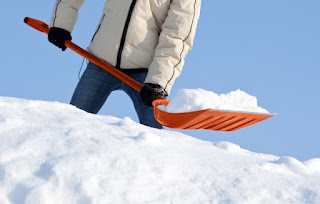Each
year at this time the Ontario Chiropractic Association launches its "Lift
Light, Shovel Right" campaign as shovelling snow becomes a more frequent part
of our routines. However, similar to
gardening in the spring, soreness and pain in the body can result from
resumption of these activities. With
respect to shovelling, commonly affected areas include the low back, neck, and
shoulders. Not surprising if you
consider that each shovel load weighs on average 5-7 pounds and that many
repetitions are required. It all adds
up! Shovelling can be a pain, both
figuratively and literally, but here are some tips to reduce the risk.
First
off, taking care of a few preparatory items is important. Wear good footwear to reduce the likelihood
of a slip and fall as that can cause a multitude of other injuries. Layering clothing is advisable to keep the
body warm and dry so you don't get a chill.
Staying well hydrated is also necessary for optimal performance of an
active body...even when it's cold outside and/or you don't "feel"
thirsty. Ensure that you have an
appropriately sized shovel for your abilities and fitness level. With a large shovel you may be able to
complete the job quickly but you increase your risk of injury. And finally, warm up for 5-10 minutes by
doing a few sets of stairs or a short walk before you start. A warmed up body, ready for activity, is one
less likely to suffer pain and discomfort.
While
shovelling, it is best to push snow as much as possible to limit both lifting
and throwing actions, which are harder on the body. When throwing onto or over a snow bank be
sure to not twist and turn through the spine but pivot at your hips and ankles/feet. With lifting, bend at your hips and knees, keep
your back straight and your stomach tightened up (i.e. spine neutral and
"braced"). Lower your bottom
hand as close to the blade as possible which will keep the load close to your
body, decreasing the effects of leverage and effectively making the load
lighter. Also, watch out for icy
patches. With thawing and re-freezing,
ice can form which not only increases the slip and fall risk but it is much
more difficult to remove. You can have
substantial jarring when you push into an ice ridge with those forces being
absorbed by your body. Depending on your
level of physical fitness, purchasing an ice chipper may be a wise decision.
 Other
considerations to minimize your risk of experiencing pain with snow shovelling
include attacking the job in small batches so you can recover between
bouts. Recruiting additional help from
your spouse, partner, kid(s), or a friend makes the job smaller and possibly
even enjoyable. Maybe a snow ball fight
breaks out, without ice chunks of course.
'Tis the season after all. Just
make sure you don't hit the cars! Taking
breaks, as necessary, can also help alleviate strains and fatigue. Furthermore, maintaining a friendly relationship
with a snow-blower owning neighbour is not a bad idea. Paying for a tank of gas or some other
simple, appreciative gesture can go a long way toward keeping your shovelling
to a minimum!
Other
considerations to minimize your risk of experiencing pain with snow shovelling
include attacking the job in small batches so you can recover between
bouts. Recruiting additional help from
your spouse, partner, kid(s), or a friend makes the job smaller and possibly
even enjoyable. Maybe a snow ball fight
breaks out, without ice chunks of course.
'Tis the season after all. Just
make sure you don't hit the cars! Taking
breaks, as necessary, can also help alleviate strains and fatigue. Furthermore, maintaining a friendly relationship
with a snow-blower owning neighbour is not a bad idea. Paying for a tank of gas or some other
simple, appreciative gesture can go a long way toward keeping your shovelling
to a minimum!
Stop
shovelling if you experience sudden or prolonged muscle or joint pain and
consider seeing a health care professional if it persists longer than a few
days. If you experience severe chest
pain contact a medical doctor immediately.
This article is for general information purposes only and is not to be
taken as professional medical advice.

No comments:
Post a Comment